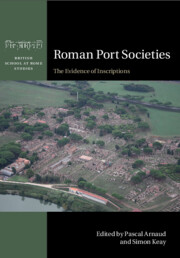Book contents
- Roman Port Societies
- British School at Rome Studies
- Roman Port Societies
- Copyright page
- Contents
- Figures
- Tables
- Contributors
- Abbreviations
- 1 The Context of Roman Mediterranean Port Societies
- 2 Inscriptions and Port Societies
- 3 Stationes and Associations of Merchants at Puteoli and Delos
- 4 Boatmen and their Corpora in the Great Ports of the Roman West (Second to Third Centuries AD)
- 5 Roman Port Societies and Their Collegia
- 6 Port Occupations and Social Hierarchies
- 7 Warehouse Societies
- 8 The Imperial Cult and the Sacred Bonds of Roman Overseas Commerce
- 9 Law and Life in Roman Harbours
- 10 Living Like a Cosmopolitan?
- 11 Ports, Trade and Supply Routes in Western Europe
- 12 The Port Society of Narona
- 13 Municipal Authority, Central Authority and Euergetists at Work at the Port
- 14 The Structure of Mercantile Communities in the Roman World
- 15 Polysemy, Epigraphic Habit and Social Legibility of Maritime Shippers
- 16 Reading Roman Port Societies
- Indexes
- References
2 - Inscriptions and Port Societies
Evidence, ‘Analyse du Discours’, Silences andPortscapes
Published online by Cambridge University Press: 30 October 2020
- Roman Port Societies
- British School at Rome Studies
- Roman Port Societies
- Copyright page
- Contents
- Figures
- Tables
- Contributors
- Abbreviations
- 1 The Context of Roman Mediterranean Port Societies
- 2 Inscriptions and Port Societies
- 3 Stationes and Associations of Merchants at Puteoli and Delos
- 4 Boatmen and their Corpora in the Great Ports of the Roman West (Second to Third Centuries AD)
- 5 Roman Port Societies and Their Collegia
- 6 Port Occupations and Social Hierarchies
- 7 Warehouse Societies
- 8 The Imperial Cult and the Sacred Bonds of Roman Overseas Commerce
- 9 Law and Life in Roman Harbours
- 10 Living Like a Cosmopolitan?
- 11 Ports, Trade and Supply Routes in Western Europe
- 12 The Port Society of Narona
- 13 Municipal Authority, Central Authority and Euergetists at Work at the Port
- 14 The Structure of Mercantile Communities in the Roman World
- 15 Polysemy, Epigraphic Habit and Social Legibility of Maritime Shippers
- 16 Reading Roman Port Societies
- Indexes
- References
Summary
One question that arises from a study of ports iswhether or not there existed a pattern of portsocieties. A Roman port society means theindividuals and groups who together with variouslevels of administration made port life real, aswell as their relationships and the rules of thesocial game. Using the plural presupposes that thesecould vary through time and space. Ports were notsimply an administrative machine whose details stillpuzzle us. They were also cosmopolitan placesdevoted to profit that involved a complex set ofprofessions and people of various origins and socialstatus, with various patterns of organization andnetworking (citizenship, language, religion, guilds,personal patronage, family in its wider sense), whowere able to combine in a great variety of ways. Atthis point one wonders whether there was a patternof society that was common to ports across theEmpire as a whole. Were there several patterns thatcould help us better understand or identify porthierarchies and the organization and layout ofports?
- Type
- Chapter
- Information
- Roman Port SocietiesThe Evidence of Inscriptions, pp. 36 - 62Publisher: Cambridge University PressPrint publication year: 2020
References
- 1
- Cited by



